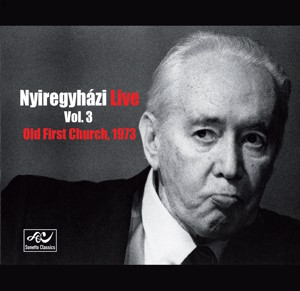
Ervin Nyiregyházi (piano)
Live Volume 3 – Old First Church, 1973
rec. live, 6 May 1976, Old First Church, San Francisco
Sonetto Classics SONCLA007 [2 CDs: 87]
The booklet accompanying this release includes a note from the producer Tomoyuki Sawado. He explains that the pianist Ervin Nyiregyházi posthumously donated his personal archive to the Takasaki Art Center College (TACC), Japan. Over the years, this valuable resource has been added to by family members and friends, but had not been accessible to the public. In 2012, due to financial problems, creditors seized the archive and in 2016 Sonetto Classics acquired ownership. It includes tapes, film material, compositions, photographs and letters.
This new album is the third that Sonetto Classics have issued of the pianist’s live recordings. I’ve had the pleasure of reviewing the previous two, which can be found here (Volume 1 ~ Volume 2). The producer says that this is the final edition in the Nyiregyházi Live trilogy. It documents one of the pianist’s most important recitals, that given in the Old First Church (Presbyterian) on 6 May, 1973. The release marks the fiftieth year of this significant musical event. It’s important to stress from the outset that allowances have to be made for the sound quality of the recording, and a caveat in the liner states that “the album includes noises, sound fluctuations and audio dropouts that were present in the source material”.
Nyiregyházi was born in Budapest in 1903 and began piano lessons aged five. His prodigious gifts were recognized early on by psychologist Géza Révész who observed him from the age of six to twelve and later published a book about him The Psychology of a Musical Prodigy. Like Menuhin, his earning potential as a gifted wunderkind led to him being exploited by his parents, and this parental domination and control may have sown the seeds of his later determination to assert his individuality and go his own way. He could claim a distinguished pedigree, as his teachers included Ernő Dohnányi and Frederic Lamond. After several concerts, including a Carnegie Hall debut, he descended into obscurity. It seems his career was mismanaged, and this was compounded by stage fright and the struggles he encountered in coping with professional and domestic life. For a time he was destitute and slept rough. He was voracious sexually and married ten times. In the 1970s he made something of a comeback, and between 1972 and 1984 he set down several studio recordings and performed some private concerts. He died in Los Angeles on April 8, 1987.
CD 1 begins with the most substantial work in the recital, Franz Schubert’s Wanderer Fantasy. The sound quality is rather harsh at the beginning, but improves as the onward journey progresses. The performance is overwhelming in its power. OK, there are some wrong notes, erratic tempi fluctuations and, at times, these abrupt gear changes can have a destabilizing effect. The playing provides a snapshot of nineteenth century romantic piano playing, with its rhythmic freedom and desynchronisation of hands. I found the sequence of variations on the 1816 song “Der Wanderer” quite mesmeric. Nyiregyházi calls time in true virtuosic fashion with coruscating brilliance.
I much prefer the pianist’s performance of Liszt’s Two Legends. He conjures up some wonderful colourful sonorities in No. 1: St. Francis of Assisi preaching to the birds. Utilizing myriad pianistic effects such as tremolos and trills, he paints a radiant impressionistic canvas of avian gatherings. No. 2: St Francis of Paola walks on the waves is a hymn of thanksgiving for a safe crossing of the Straits of Messina. The journey was not without its dangers, and the menacing chromatic scales bear witness to the event. Nyiregyházi delivers a reading of great tumult and thunderous power.
CD 2 contains a selection of shorter works. Nyiregyházi begins with two pieces by Chopin. The Mazurka in C sharp minor, Op. 6 No. 2 is brooding and melancholic and weighed down with sorrow and despair. The Nocturne in F minor, Op. 55 No. 1 is similarly cast in dark hues. The doleful quality is further emphasized by the very slow tempo Nyiregyházi takes. Debussy’s Pagodes is expressively wrought, but La plus que lente is too heavily laden and lacks exoticism and mystique -a miscalculation in my view. Brahms Rhapsody in E flat major Op. 119 No. 4 is writ large and big boned in conception. The pianist draws a huge tone from the piano, as he does in the first of his encores, which is Theodor Leschetizky’s Étude héroïque, Op. 48 No. 3. It’s a scintillating tour de force. In contrast, the second encore, the Schubert/Liszt Schwanengesang: No. 4, Am Meer is soulful and serene.
The liner notes, in English and Japanese, come courtesy of the pianist’s biographer Kevin Bazzana. They are both well-written and informative. I would thoroughly recommend Bazzana’s biography of the pianist: Lost Genius: The Story of a Forgotten Musical Maverick. Tomoyuki Sawado and Andrew J. Holdsworth have made every effort in their remasterings to overcome some of the inadequacies of the original source material. The album will appeal both to fans of Ervin Nyiregyházi and aficionados of the art of piano.
Stephen Greenbank
Contents
CD 1
Franz Schubert
“Wanderer” Fantasy in C Major, Op. 15, D. 760
Franz Liszt
Deux légendes
No. 1, St. François d’Assise: la prédication aux oiseaux
No. 2, St. François de Paule marchant sur les flots
CD 2
Frédéric Chopin
Mazurka in C-sharp Minor, Op. 6/No. 2
Nocturne in F Minor, Op. 55/No. 1
Claude Debussy
Estampes: No. 1, “Pagodes”
La plus que lente
Johannes Brahms
Rhapsody in E-flat Major, Op. 119/No. 4
Encores
Theodor Leschetizky
Étude héroïque, Op. 48/No. 3
Schubert-Liszt
Schwanengesang: No. 4, “Am Meer”
Availability: Sonetto Classics


















